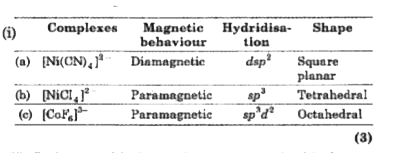Compare the following complexes with respect to structural shapes, magnetic behaviour and hybrid orbitals involved. (a)[Ni(CN)4]2−(b)[NiCl4]2−(c)[CoF6]3−
[Atomic number of Co= 27, Cr = 24, Ni= 28]
Similar Questions
Compare the following complexes with respect to structural shapes of units , magnetic behaviour and hybrid orbitals involved in units
(i) [Ni(CN)4]2−
(ii) [NiCl4]2−
(iii) [At . Nos .: Ni =28 , Co =27]
View SolutionCompare the following complexes with respect to structural shapes of units , magnetic behaviour and hybrid orbitals involved in units
(i) [Ni(CN)4]2−
(ii) [NiCl4]2−
(iii) [At . Nos .: Ni =28 , Co =27]
View Solution
Knowledge Check
Amongst Ni(CO)4,[Ni(CN)4]2− and [NiCl4]2−
ANl(CO)4is diamagnetic, [NlCl4]2− and [Ni(CN)_4]^(2-) are paramagneticBNl(CO)4 and[Ni(CN)4]2− are diamagnetic and [Nl(CN)4]2− is paramagneticCNl(CO)4 and [Nl(CN)4]2− are diamagnetic and [NiCl4]2− is paramagneticD[NiCl4]2− and [Ni(CN)4]2− are diamagnetic and Ni(CO)4 is paramagneticThe hybridisation involved in complex [Ni(CN)4]2− is (At. No. Ni = 28)
Asp3Bd2sp2Cd2sp3Ddsp2
Compare the following complexes with respect to structural shapes of units, magnetic behaviour and hybrid orbitals involved in units [Co(NH3)6]3+,[Cr(NH3)6]3+,[Ni(CO)4]
[At.Nos.:Co=27,Cr=24,Ni=28]
View SolutionExplain the following complexes with respect to structural shapes of units, magnetic behaviour and hybrid orbitals involved in the units :
[Cr(NH3)6]3+ , [Ni(CO)4]
View SolutionCompare the following complexes with respect to structural shapes of units, magnetic behaviour and hybrid orbitals involved in units :
[Co(NH3)6]3+,[Cr(NH3)6]3+,Ni(CO)4
View SolutionCompare the following complexes with respect to their shape , magnetic behaviour and the hybrid orbitals involved :
(i) [CoF4]2− (ii)[Cr(H2O)2(C2O4)2]− (iii)[Ni(CO)4]
(Atomic number : Co = 27 , Cr = 24 , Ni = 28)
View SolutionCompare the following complexes with respect to their shape , magnetic behaviour and the hybrid orbitals involved :
(i) [CoF4]2− (ii)[Cr(H2O)2(C2O4)2]− (iii)[Ni(CO)4]
(Atomic number : Co = 27 , Cr = 24 , Ni = 28)
View SolutionExplain the following complexes with respect to structural shapes of units, magnetic behaviour and hybrid orbitals involved in the units :
[Cr(NH3)6]3+ , [Cr(NH3)6]3+ , [Ni(CO)4]
View Solution

